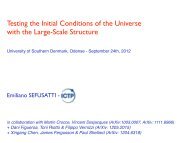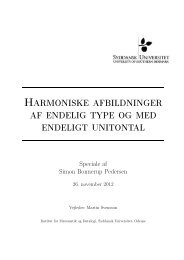A high-resolution version for printing - CP3-Origins
A high-resolution version for printing - CP3-Origins
A high-resolution version for printing - CP3-Origins
You also want an ePaper? Increase the reach of your titles
YUMPU automatically turns print PDFs into web optimized ePapers that Google loves.
Roadmap<br />
The centre is designed to cover, during its life-time, strategic areas of research orbiting around<br />
the “Origin of Mass” problem which is the “trait d’union” connecting them:<br />
• Electroweak Symmetry Breaking/Model Building<br />
• Flavour and CP Physics<br />
• Strong Interactions<br />
In the following we review the research we have been involved in during the reporting period.<br />
We plan to further extend our line or research below <strong>for</strong> the coming reporting year according to<br />
the original work-plan and milestones.<br />
Two staff members per research area will be the primary investigators according to their expertise.<br />
We expect to involve two postdocs per area of research. There is sufficient flexibility within<br />
this research structure to allow <strong>for</strong> the young researchers to pick the topic(s) which best suits<br />
their interests. Within each research project introduced below we present the methodological<br />
approach we will employ to achieve our goals.<br />
Dynamical Electroweak Symmetry Breaking<br />
A number of possible generalizations of the SM have been conceived. Such extensions are introduced<br />
on the basis of one or more guiding principles or prejudices. We will introduce below<br />
only the SM extensions on which we have worked and can achieve in a short period definite<br />
and seminal results.<br />
One of the intriguing options <strong>for</strong> explaining some of the puzzling features of the SM of particle<br />
physics is to assume that a new <strong>for</strong>ce acts at the Fermi scale. This new <strong>for</strong>ce, commonly called<br />
Technicolor – the <strong>high</strong> energy equivalent of ordinary superconductivity – leads to a natural explanation<br />
of the origin of the Fermi scale per se as well as of the origin of mass of the intermediate<br />
vector boson responsible, <strong>for</strong> example, <strong>for</strong> the slow burning of our Sun. These theories are<br />
useful <strong>for</strong> constructing models able to generate the Fermi scale dynamically while passing the<br />
LEP precision measurements. Our extensions, termed Minimal Walking Technicolor, are currently<br />
being studied <strong>for</strong> potential discovery at the LHC. These theories require new strong dynamics<br />
very different from the strong nuclear <strong>for</strong>ce QCD.<br />
Natural Fourth Families<br />
Imagine to discover a new fourth family of leptons at the Large Hadron Collider (LHC) but no<br />
signs of an associated fourth family of quarks. What would that imply? An intriguing possibility<br />
is that the new fermions needed to compensate <strong>for</strong> the new leptons gauge anomalies simultaneously<br />
address the big hierarchy problem of the Standard Model. A natural way to accomplish<br />
such a scenario is to have the Higgs itself be composite of these new fermions.<br />
CP³-Black book 11








